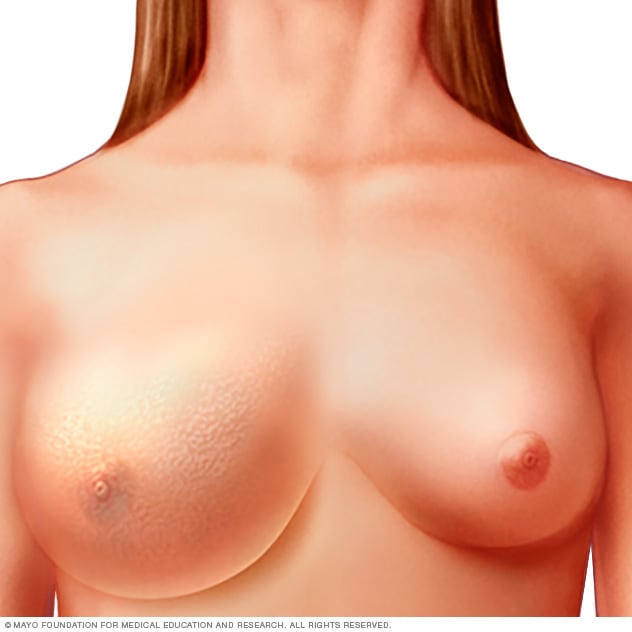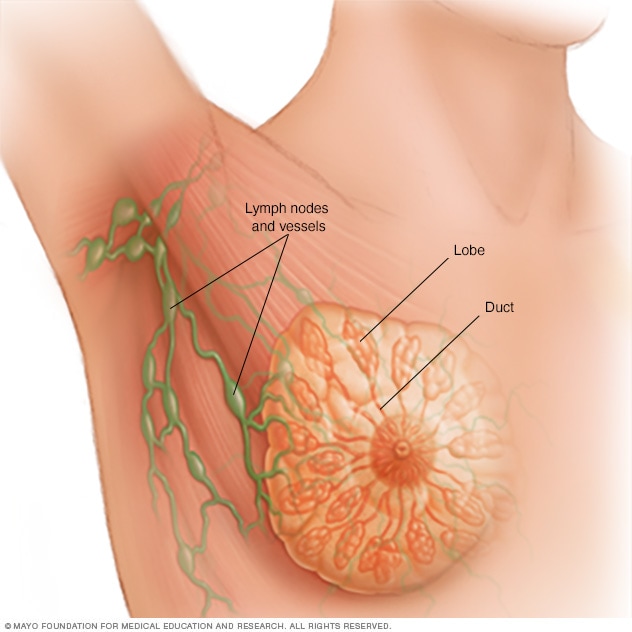نظرة عامة
سرطان الثدي الالتهابي

سرطان الثدي الالتهابي
غالبًا ما يظهر سرطان الثدي الالتهابي كثدي متضخم وجلد سميك باللون الأحمر.
سرطان الثدي الالتهابي نوع نادر من سرطان الثدي يتطور بسرعة جاعلاً الثدي المصاب أحمر اللون ومتورمًا ومؤلمًا عند اللمس.
يحدث سرطان الثدي الالتهابي عندما تسد الخلايا السرطانية الأوعية الليمفاوية في الجلد الذي يغطي الثدي، ما يتسبب في احمرار لون الثدي وتورّمه.
يعتبر سرطان الثدي الالتهابي سرطانًا متطورًا موضعيًا؛ ما يعني أنه ينتشر من نقطة بدايته إلى الأنسجة القريبة وربما إلى العُقَد اللمفية القريبة.
يمكن الخلط بسهولة بين سرطان الثدي الالتهابي وعدوى التهاب الثدي، الذي يُعد السبب الأكثر شيوعًا لاحمرار الثدي وتورمه. وفي حال لاحظتِ تغيرًا في شكل جلد ثديك، اطلبي الرعاية الطبية على الفور.
المنتجات والخدمات
الأعراض
لا يشكل سرطان الثدي الالتهابي عادةً كتلة، كما يحدث مع أشكال أخرى من سرطان الثدي. بدلاً من ذلك، تتضمن علامات سرطان الثدي الالتهابي وأعراضه ما يلي:
- تغير سريع في مظهر أحد الثديين، على مدار عدة أسابيع
- سمك وثقل أو تضخم يسهل ملاحظته في ثدي واحد
- تغير في اللون، يأخذ الثدي لونًا أحمر أو بنفسجيًا أو ورديًا أو تظهر به كدمات
- دفء غير عادي في الثدي المصاب
- تنقير أو نتوءات على جلد الثدي المصاب، تشبه قشرة البرتقال
- ضعف أو ألم أو وجع
- تضخم العُقَد اللمفية تحت الذراع، فوق عظم التُرْقُوَة أو أسفل عظم التُرْقُوَة
- تسطُّح الحلمة أو انغماسها إلى الداخل
لتشخيص سرطان الثدي الالتهابي، يجب أن تكون هذه الأعراض موجودة لمدة لا تقل عن ستة أشهر.
متى تزور الطبيب
حدِّد موعدًا مع الطبيب، إذا كان لديكَ علامات أو أعراض تُثير قلقك.
هناك حالات أخرى أكثر شيوعًا لها مؤشرات وأعراض تشبه تلك الخاصة بسرطان الثدي الالتهابي. فقد تتسبب إصابة الثدي أو عدوى الثدي (التهاب الثدي) في حدوث احمرار وتورّم وألم.
ومن السهل أن يحدث خلطٌ بين سرطان الثدي الالتهابي وعَدوى الثدي، وهو الأكثر شيوعًا. وتعتمد طريقة العلاج المقبولة والشائعة على استخدام المضادات الحيوية أولًا ولمدة أسبوع أو أكثر. فإذا استجابت الأعراض لديكِ للمضادات الحيوية، فلا حاجة لإجراء اختبارات إضافية. ولكن إذا لم يتحسن الاحمرار، فقد يفكر طبيبكِ في أسباب أكثر خطورة وراء أعراضك، مثل سرطان الثدي الالتهابي.
وإذا كنتِ قد خضعتِ للعلاج من عَدوى الثدي ولكن المؤشرات والأعراض لم تختفِ، فاتصلي بطبيبكِ. قد يوصي الطبيب بإجراء صورة الثدي الشعاعية (الماموجرام) أو اختبار غيره لتقييم مؤشرات المرض والأعراض البادية عليكِ. والطريقة الوحيدة لتحديد ما إذا كانت أعراضكِ ترجع إلى الإصابة بسرطان الثدي الالتهابي هي إجراء خزعة لإزالة عينة من الأنسجة لفحصها.
الأسباب
تشريح الثدي

تشريح الثدي
يحتوي كل ثدي على ما يتراوح بين 15 و 20 فصًا من الأنسجة الغدّية مرتبة على شكل بتلات زهرة الأقحوان. وتنقسم هذه الفصوص إلى فصيصات أصغر تُنتج الحليب اللازم للرضاعة الطبيعية. وتوجد أنابيب صغيرة، وتسمى قنوات، تنقل الحليب إلى الخزان الواقع تحت الحلمتين مباشرةً.
يحدث سرطان الثدي الالتهابي لأسباب غير واضحة.
لكن الأطباء يعلمون أن سرطان الثدي الالتهابي يبدأ عندما تحدُث تغيرات في الحمض النووي لإحدى خلايا الثدي. وغالبًا ما تكون هذه الخلية موجودة في أحد الأنابيب (القنوات) التي تحمل حليب الثدي إلى الحلمة. لكن من الوارد أن يبدأ السرطان أيضًا بخلية في النسيج الغدي (الفُصيصات) التي يُنتج فيها حليب الثدي.
يحتوي الحمض النووي للخلية على التوجيهات التي تدل الخلية على ما عليها القيام به. وتلك التغيرات في الحمض النووي تخبر خلية الثدي أن عليها النمو والانقسام بسرعة. وتبدأ الخلايا الشاذة المتراكمة في اختراق الأوعية اللمفاوية الموجودة في جلد الصدر وتسبب انسدادها. يؤدي انسداد الأوعية اللمفاوية إلى احمرار الجلد وتورمه وتنقره؛ وهي من المؤشرات المشهورة للإصابة بسرطان الثدي الالتهابي.
عوامل الخطر
تشمل العوامل التي تزيد من خطر الإصابة بسرطان الثدي الالتهابي ما يلي:
- أن تكوني امرأة. تزداد احتمالية التشخيص بالإصابة بسرطان الثدي الالتهابي لدى النساء عنها لدى الرجال - ولكن يمكن أن يصاب الرجال بسرطان الثدي الالتهابي أيضًا.
- أن تكوني أصغر سنًا. يتم تشخيص الإصابة بسرطان الثدي الالتهابي بمعدل أكثر تكرارًا لدى الأشخاص في الأربعينيات والخمسينيات من العمر.
- أن تكوني سوداء البشرة. النساء ذوات البشرة السوداء أكثر عرضة للإصابة بسرطان الثدي الالتهابي من النساء ذوات البشرة البيضاء.
- أن تكوني بدينة. الأشخاص المصابون بالسُمنة أكثر عرضة للإصابة بسرطان الثدي الالتهابي مقارنة بالأشخاص ذوي الوزن الطبيعي.
Being female
Women are much more likely than men to get breast cancer, including inflammatory breast cancer. Everyone is born with some breast tissue, so anyone can get breast cancer.
Being younger
Inflammatory breast cancer is more frequently diagnosed in people in their 40s and 50s.
Being Black
Black people have a higher risk of inflammatory breast cancer than do white people.
Being obese
People who are obese have a greater risk of inflammatory breast cancer.
الوقاية
Making changes in your daily life may help lower your risk of breast cancer. Try to:
Ask about breast cancer screening
Talk with your doctor or other healthcare professional about when to begin breast cancer screening. Ask about the benefits and risks of screening. Together, you can decide what breast cancer screening tests are right for you.
Become familiar with your breasts through breast self-exam for breast awareness
You may choose to become familiar with your breasts by occasionally inspecting them during a breast self-exam for breast awareness. If you find a new change, lumps or other unusual signs in your breasts, tell a healthcare professional right away.
Breast awareness can't prevent breast cancer. But it may help you to better understand the look and feel of your breasts. This might make it more likely that you'll notice if something changes.
Drink alcohol in moderation, if at all
If you choose to drink, limit the amount of alcohol you drink to no more than one drink a day. For breast cancer prevention, there is no safe amount of alcohol. So if you're very concerned about your breast cancer risk, you may choose to not drink alcohol.
Exercise most days of the week
Aim for at least 30 minutes of exercise on most days of the week. If you haven't been active lately, ask your healthcare professional whether exercising is OK and start slowly.
Limit hormone therapy during menopause
Combination hormone therapy may increase the risk of breast cancer. Talk with a healthcare professional about the benefits and risks of hormone therapy.
Some people have symptoms during menopause that cause discomfort. These people may decide that the risks of hormone therapy are acceptable to get relief. To reduce the risk of breast cancer, use the lowest dose of hormone therapy possible for the shortest amount of time.
Maintain a healthy weight
If your weight is healthy, work to maintain that weight. If you need to lose weight, ask a healthcare professional about healthy ways to lower your weight. Eat fewer calories and slowly increase the amount you exercise.